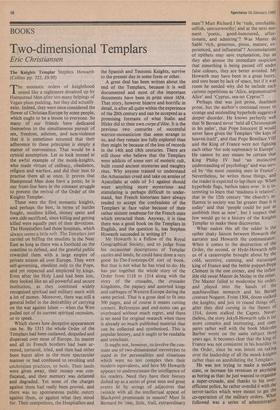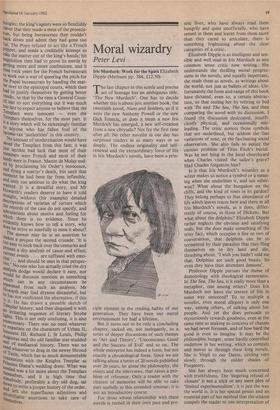BOOKS
Two-dimensional Templars
Eric Christiansen
The Knights Templar Stephen Howarth (Collins pp. 322, £9.95) The monastic orders of knighthood sound like a nightmare dreamed up by Hampstead Man after too many helpings of Vegan plum pudding, but they did actually exist. Indeed, they were once considered the flower of Christian Europe by some people, which ought to be a lesson to everyone. So many of our friends have dedicated themselves to the simultaneous pursuit of sex, freedom, atheism, and non-violence that it is sometimes assumed that their adherence to these principles is simply a matter of convenience. That would be a cynical assumption. Let us look instead at the awful example of the monk-knights, who made virtues of celibacy, obedience, religion and warfare, and did their best, to practise them all at once. It proves that Hampstead Man does have a point; he is our front-line hero in the constant struggle to prevent the revival of the Order of the Knights Templar.
These were the first monastic knights, and perhaps the best, in terms of battles fought, muslims killed, money spent and own side sacrificed, since killing and getting killed were equally part of their devotions. The Hospitallers had those hospitals, which always seems a little soft. The Templars just carried on biffing the muslims in the Near East as long as there was a foothold on the coastline to defend, and the grateful public rewarded them with a large empire of private estates all over Europe. They were self-governing, obedient only to the Pope, and yet respected and employed by kings. Even after the Holy Land had been lost, they looked like an all-powerful and secure institution, as they combined widely recognised spiritual and military merit with a lot of money. Moreover, there was still a general belief in the desirability of carrying on the war against Islam — when the West pulled out of its current spiritual recession, so to speak. Which shows how deceptive appearances can be. By 1315 the whole Order of the Templars had been outlawed, despoiled and dispersed over most of Europe. Its master and all its French brothers had been ar- rested, tortured, tried, and then had either been burnt alive in the most spectacular manner or had confessed to revolting and unchristian practices, or both. Their lands were given away, their money was con- fiscated, and their memory was defamed and degraded. Yet none of the charges against them had really been proved, and there was no spontaneous public outcry against them, or against what they stood for. Their competitors, the Hospitallers and the Spanish and Teutonic Knights, survive to the present day in some form or other.
A great deal has been written about the end of the Templars, because it is well documented and most of the important documents have been in print since 1654. That story, however bizarre and horrific in detail, is after all quite within the experience of the 20th century and can be accepted as a promising foretaste of what Stalin and Hitler did to their own corps d'elite. It is the previous two centuries of successful warrior-monasticism that seem strange to us, and they remain less fully explored than they might be because of the loss of records in the 14th and 18th centuries. There are still those who believe that the Templars were addicts of some sort of esoteric cult, built round ancient mysteries and naughty rites. Why anyone trained to understand the Athanasian creed and take on armies of Ayatollahs at odds of 3-1 against should want anything more mysterious and stimulating is perhaps difficult to under- stand, but French historians have always tended to accept the confessions of the Templars at face value because of their rather sinister tendresse for the French state which extracted them. Anyway, it is time there was a good book on the Templars in English, and the question is, has Stephen Howarth succeeded in writing it?
Mr Howarth is a Fellow of the Royal Geographical Society, and to judge from his occasional descriptions of Templar castles and lands, he could have done a very good In-The-Footsteps-Of sort of book. But that is not what he has tried to do. He has put together the whole story of the Order from 1118 to 1314 along with the story of the crusades, the crusader kingdoms, the papacy and assorted kings and cabbages of Western Europe during the same period. That is a great deal to fit into 300 pages, and of course it means cutting corners. References and end-notes can go overboard without much regret, and there is no need for original research when there is already so much published material that can be collected and synthesised. This is popular history, and it ought to be readable and trenchant.
It ought not, however, to involve the con- stant use of two-dimensional stereotypes to stand in for personalities and situations which were no less complex then their modern equivalents, and here Mr Howarth appears to underestimate the intelligence of his readers. Need they have their history dished up as a series of great men and great events lit by strings of adjectives that twinkle with all the intellectual appeal of Blackpool promenade in season? Must St Bernard be 'one, little, frail, extraordinary
man'? Must Richard I be 'rude, unreliable, selfish, untrustworthy; and at the next mo- ment 'poetic, good-humoured, affec- tionate, and admiring'? Was Master de Sable 'rich, generous, pious, mature, ex- perienced, and influential'? Accumulations of epithets may save explanation, but as they also arouse the immediate suspicion that something is being passed off under false colours, they are better avoided. Mr Howarth may have been in a great hurry, and sore beset by lack of space, but if it was room he needed why did he include such curious repetitions as 'Alice, argumentative Alice' and 'Cyprus, sea-set Cyprus'?
Perhaps that was just prose, deathless prose, but the author's continual resort to strange and misleading hyperbole suggests a deeper disorder. He knows perfectly well that St Bernard never 'held all Christendom in his palm', that Pope Innocent II would never have given the Templars 'the keys of heaven itself', and that Pope Boniface VI11 and the King of France were not fighting each other 'for sole supremacy in Europe'. He cannot by any means be certain that King Philip IV had 'an instinctive understanding of psychology' and was serv- ed by 'the most cunning men in France'. Nevertheless, he writes those things, and the reader is expected to lap them up. When hyperbole flags, bathos takes over. It is in- teresting to learn that 'madness is relative', that in the 12th century 'the church's in- fluence in society was far greater than it is today' and that 'people could be just as snobbish then as now', but I suspect that few would go to a history of the Knights Templar to make these discoveries.
What makes this all the odder is the rather shaky liaison between Howarth the narrator and Howarth the commentator. When it comes to the destruction of the Order, the second, or Hyde-Howarth tells us of a catastrophe brought about by the cold, secretive, cunning, and statuesque king of France and the feeble puppet-Pope Clement in the one corner, and the inflex- ible old sweat Master de Malay in the other. The Master failed to modernise his order, and played into the hands of the machiavellian monarch and his Berian creature Nogaret. From 1304, doom stalked the knights; and just to round things off, after they died cursing in the flames of 1314, doom stalked the Capets. Never- theless, the story Jekyll-Howarth tells is far more complex and interesting, and com- pares rather well with the book Malcolm Barber wrote on the same subject three years ago. It becomes clear that the king of France was not consistent in his hostility to the Order, since he was intent on taking over the leadership of all the monk-knights rather than on annihilating the Templars. He was not trying to make a modern state, or increase his revenues or anything as boring as that: he just wanted to organise a super-crusade, and thanks to his over- efficient police, he rather overdid it with the terror-tactics which were meant to get the co-operation of the military orders. What followed was a series of administrative bungles; the king's agents were so fiendishly clever that they made a mess of the prosecu- tion, but being bureaucrats they couldn't back down and admit they had gone too far. The Pope refused to act like a French Puppet, and made a creditable attempt to take the matter out of the king's hands; his inquisition then had to prove its mettle by setting more and more confessions, and it then took years for the French bureaucrats to work out a way of queering the pitch for the Papal bureaucrats by handing the mat- ter over to the episcopal courts, which then had to justify themselves by getting better results, so that by the time a General Coun- cil met to sort everything out it was much t°0 late to expect anyone to believe that the ,,,, ernplars were innocent — even the ,ri eiriPlars themselves, for the most part. It is a story which will be sickeningly familiar to anyone who has fallen foul of the 19come-tax 'authorities' in this country. No amount of modernisation would have saved the Templars from this fate; it was lust terrible bad luck that most of their ;heathers were French and most of their 'ands were in France. Master de Molay end- ed by proclaiming his Order's innocence, and dying a martyr's death, but until that Moment he had been far from inflexible, and only too anxious to do what the king wanted. It is a dreadful story, and Mr Howarth's readers deserve to have it told st, ralght, without (for example) detailed descriptions of varieties of torture which the records of the case do not specify, and speculations about motive and feeling for Which there is no evidence. Since he does knows how to tell a story, why
he strive so manfully to mess it about?
The answer may lie in an assertion he tn -es a propos the second crusade: 'It is easy to look back over the centuries and ic)resent a dry analysis of cause and effect; current events .... are suffused with emo- t,1" • • and should be seen in that perspec- 've.' No-one who has actually tried the dry „,analYsis dodge would declare it easy, nor ii,",n!ild he discount emotion as something ..11ch can in any circumstances be separated from such an analysis. Mr ,loWarth may find dryness distasteful, but flas not vindicated the alternative, if this is it. He has drawn a passable sketch of Templar history, and then disguised it with lights. ri irritating sequence of literary Strobe This is not only confusing, it is also unnecessary. There was no need whatever t° expatiate on the characters of Urban II, Innocent III, Richard I, St Louis, Philip Augustus and the old familiar star-studded need of mediaeval history. There was no 4ec1 whatever to drag in the newsy Shroud e Turin, which has as much demonstrable ?on nection with the Knights Templar as „rheess Diana's wedding dress. What was *leeded was a lot more about the Templars _Inelnselves, and it is high time that 'dc'inebody, preferably a dry old dogs sat and left to write a proper history of the order, "ricl left the superfluous adjectives and theta ernsverifiable assertions to take care of
elves.



































 Previous page
Previous page